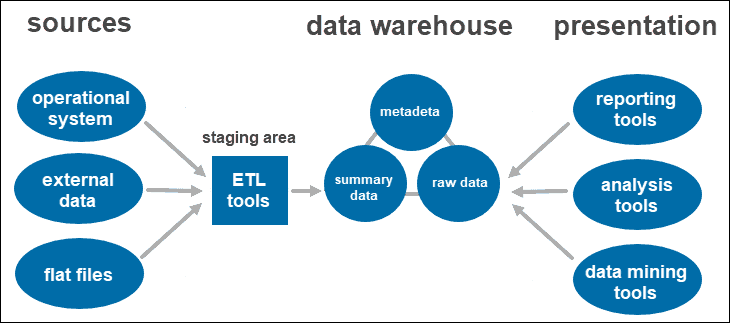Data Warehouse: A Comprehensive Guide
Introduction to Data Warehouse
A data warehouse is a centralized repository of structured and organized data that is used for reporting, analysis, and decision-making purposes. It enables organizations to store and manage large amounts of data in a single location, making it easier to access, analyze, and report on.
Why Should You Have a Data Warehouse?
A data warehouse provides many benefits to organizations, including:
- Improved data management: By centralizing data in a single location, data warehousing makes it easier to manage and access large amounts of data.
- Enhanced decision-making: A data warehouse provides a single source of truth for business data, enabling organizations to make informed decisions based on accurate and up-to-date information.
- Increased efficiency: Data warehousing streamlines the process of accessing and analyzing data, saving time and increasing efficiency.
Architecture of Data Warehouse
The architecture of a data warehouse typically consists of the following components:

- Data Sources: The data sources provide the raw data that is fed into the data warehouse. This data can come from a variety of sources, including transactional systems, log files, and external sources.
- Extraction, Transformation, and Loading (ETL) process: The ETL process is responsible for extracting data from the various data sources, transforming the data into a standardized format, and loading it into the data warehouse.
- Data Warehouse Database: The data warehouse database is a centralized repository for storing the structured and organized data that has been loaded from the various data sources.
- Data Marts: Data marts are subsets of the data warehouse that are optimized for specific business functions or departments. They provide a more targeted view of the data for specific groups of users.
- OLAP (Online Analytical Processing) Cubes: OLAP cubes are multi-dimensional data structures that are used to support advanced analytics and reporting. They provide a flexible and efficient way to access and analyze data in the data warehouse.
- Data Mining and Analytics Tools: Data mining and analytics tools are used to analyze and interpret the data in the data warehouse. These tools can be used to identify patterns, trends, and insights that can inform decision-making and drive business success.
- User Interfaces: User interfaces, such as dashboards and reports, provide access to the data and insights generated by the data warehouse. They enable users to view, interact with, and make sense of the data.
Popular Data Warehouses 2023
Some of the most popular data warehouses in 2023 include:
- Amazon Redshift
- Databricks Delta Tables
- Google BigQuery
- Snowflake
- Microsoft Azure Synapse Analytics
Types of Data Warehouse
There are three main types of data warehouses:
- Traditional data warehouse: This type of data warehouse is built on a relational database and is designed to support structured data.
- Data warehouse appliance: This type of data warehouse is a pre-configured and optimized system that is designed for data warehousing.
- Cloud data warehouse: This type of data warehouse is hosted in the cloud and is designed for scalability and ease of use.
Benefits of Data Warehouse
Some of the key benefits of data warehousing include:
- Improved data quality: Data warehousing ensures that data is accurate, consistent, and up-to-date, improving the quality of information used for decision-making.
- Increased insights: Data warehousing enables organizations to gain insights into their operations by combining data from multiple sources into a single view.
- Improved reporting and analysis: Data warehousing makes it easier to report on and analyze data, providing a more comprehensive view of business operations.
Results
The results of data warehousing can be significant for organizations, including:
- Better decision-making: With access to accurate, up-to-date information, organizations can make more informed decisions.
- Increased efficiency: By streamlining the process of accessing and analyzing data, data warehousing can increase efficiency and save time.
- Improved performance: Data warehousing can provide insights into business operations, enabling organizations to identify areas for improvement and optimize performance.
Conclusion
Data warehousing is an essential tool for organizations that want to improve their data management, decision-making, and performance. With its ability to store, manage, and analyze large amounts of data in a single location, data warehousing provides organizations with a comprehensive view of their operations, enabling them to make informed decisions and drive success.
What’s next?
Want to learn more.
We have number of solutions to help you to modernize your Data Warehouse.
1. Free Data Architecture Consultation
2. Pay as you go data resources
3. Robotic Process Automation
4. Data Warehouse Solution
5. Big Data and BI
Visit our website and contact us today.
Contact us today to learn how can Dlytica help you for your next step.
Contact Us : https://www.dlytica.com/contact-us/
Official Site : https://www.dlytica.com/
Linkedin : https://www.linkedin.com/company/dlytica/
Recent Post
Globally, most banks face one of the most significant issues with non-performing assets, or NPAs. For instance, the NPA ratio in India has decrea [...]
What Is a Sovereign AI Lakehouse Platform? A sovereign AI lakehouse platform unifies data lake and data warehouse capabilities with built‑in AI t [...]
Why Enterprises Are Choosing DataNature over Cloudera, Databricks, and Snowflake? Across Canada, banks, telcos, and public-sector organizations a [...]
Empowering businesses with unified data, intelligent automation, and real-time insights. Introduction: How an AI Data Platform Drives Enterprise [...]
Introduction Artificial Intelligence (AI) is quickly changing industries, and this is most obvious in the finance and banking worlds. From fraud [...]
Introduction In today’s digital environment, data-driven technologies are reshaping how companies operate. Every day, organizations produce enorm [...]
Introduction Customer data is growing at lightning speed, but making sense of it remains a challenge. This is where AI agents in customer analyti [...]
Introduction Big Data and AI are transforming the way businesses handle massive datasets. In today’s fast-paced digital world, organizations stru [...]
Introduction The Banking and Financial Services (BFSI) industry is at the edge of a major transformation. With rising customer expectations, incr [...]
Introduction In the rapidly evolving world of technology, the development of customized Large Language Models (LLMs) is a frontier being explored [...]
Introduction: In the rapidly evolving technology landscape, Data and Artificial Intelligence (AI) are reshaping industries and revolutionizing bu [...]
Introduction: Language is the glue that connects us in this digital age. From chatbots that converse with us to virtual assistants that understan [...]
In the modern business landscape, data is the new oil, powering decisions and strategies across sectors. Dlytica Inc., with its cutting-edge data [...]
Data Analyst: A Data Analyst scrutinizes numeric data to aid companies in making informed decisions. They are often the entry point for individua [...]
Introduction Collision 2023, the largest AI event of the year, served as a vibrant hub of innovation, collaboration, and knowledge-sharing. In th [...]
Overview Intelligent Document Processing (IDP) is an Artificial Intelligence (AI)-driven technology that is rapidly transforming the way business [...]
Overview In today’s fast-paced business world, companies generate a vast amount of data, most of which is stored in paper-based or unstructured d [...]
Overview The insurance industry generates a vast amount of unstructured, semi-structured and structured documents in the form of policies, claims [...]
Overview Intelligent Document Processing (IDP) refers to the use of Artificial Intelligence (AI) technologies to automate the data extraction pro [...]
In the digital age, businesses are constantly looking for ways to streamline their operations and increase efficiency. One area that holds great [...]
Overview: Intelligent Document Processing (IDP) refers to the automated process of analyzing, extracting, and categorizing data from various type [...]
Introduction: Cloud computing is a technology that allows users to store, access, and manage data and applications over the internet. Instead of [...]
Introduction to Resource Augmentation IT resource augmentation services are a growing trend in the business world, as organizations look for ways [...]
Introduction to Data Warehouse A data warehouse is a centralized repository of structured and organized data that is used for reporting, analysis [...]
Overview: Robotic process automation (RPA) is a software technology that makes it easy to build, deploy, and manage software robots that emulate [...]
How can AI automate Insurance Industry? In this article, you will learn : What is Insurance Claim Process Automation? Claims Processing is t [...]
What is CMAP? One of the premium solution provided by Dlytica is Cloud Migration Acceleration program (CMAP).Migrate to cloud with our suppo [...]
With an Innovative team at DLytica, we work on converting your Data Strategies to Solutions. We leverage a team of skilled Data Architects, Data [...]
Who are we? Company’s tagline : Drive your business with Data Analytics and AI with DLytica Inc. With an Innovative team at DLytica, we [...]
Overview: Fraud is evolving and nowadays it looks more like organized crime with international and cross-functional teams involved. It means that [...]
